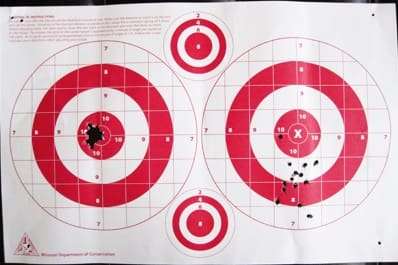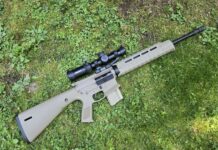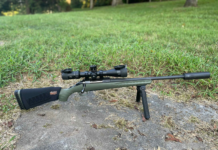I have a confession to make. I’m a rifle virgin. Or almost one. I don’t really own a rifle and don’t know all that much about them. OK, I own a Sub-2000 and some will say that counts. But I don’t consider that a rifle. It shoots handgun ammo (9mm). I started out shooting with shotguns. I’m not a hunter. I shoot those little orange non-bird birds. I’ve shot some skeet and sporting clays, but my first love is trap. I have a carry license so own handguns, too. So I really haven’t had to think much about ballistics. Until now . . .
I’d given my son a Henry lever action .22 a couple of years ago for Christmas. And no, he hasn’t put his eye out. Yet. Anyway, he also had a cheap – and I mean CHEAP – BSA scope kicking around that he’d bought for an Airsoft gun about a decade ago. Mostly because it looked cool, I think. So I decided to put the scope on the rifle.
Well, even I know you can’t just put the scope on the rifle and expect to hit anything. You have to sight it in. Zero that baby, right? I mounted the scope and it was off to the range I went.
I got set up with the target at 25 yards, used a rest and squeezed off a few. And thought I was shooting blanks. That’s right. Nothing was hitting paper, let alone a ring. I made some adjustments, trying to guess which way I was off, but no luck.
Fine. I moved the target back to ten yards and started to, you know, hit the target. A few clicks right and a few (OK, a LOT of) clicks up and I was getting somewhere. So, back out to 25 yards I went. I would have zeroed the thing at 50 yards, but I don’t have a spotting scope.
Anyway, what I learned is that yes, Virginia, ammunition really does make a big difference. OK, I knew that intellectually. I’ve casually read about what different ammo characteristics will do. But I’d never experienced this first hand before.
What we have above: two full Henry magazines (14 rounds) shot at 25 yards. On your left I used CCI 36 grain Mini-Mag HP. On your right was Winchester Super-X 40 grain Subsonic.
The CCIs are rated at 1260 fps while the Winchester comes in at 1065 fps. Sure, this is a pretty significant difference, but I wouldn’t have expected such a disparity at only 25 yards. A 1” group compared to a 3.5” group. And I don’t think I can blame the gun.
Both flavors are considered “varmint” rounds. In places other than Canuckistan, they’re good for shooting gophers and other small pesky creatures. But take a look at those results. I’m not sure shooting the Winchesters will keep you inside a minute of squirrel.
Now, if you had asked me how much difference you’d see between ANY two .22lr rounds at only 25 yards, I’d have answered, “zilch.” Or darn close to it. But the scales have fallen from my eyes. Never having actually shot a varmint, I’m pretty sure, given my recent education, that a slower moving heavier bullet isn’t the way to go. If you want to actually, you know, hit it that is.
I’m sure most of you already know all of this and I seem like a hopeless newb recounting painfully obvious results. But remember, I’m new to all of this. What’s next? And please: be gentle with me.





Same here. Was always a handgun guy till buying a 5R in .308 and shooting at 100yards+. Couldn’t believe the difference and developed a healthy respect for the art and science behind rifle shooting. Now I’m hooked but am not reloading yet so am buying on luckygunner.com.
“I’m pretty sure, given my recent education, that a slower moving heavier bullet isn’t the way to go.
I don’t think that is the correct conclusion. With high quality ammo you could have just as easily had a tighter group that was an inch or two lower. That, and some rifles like certain ammo and some don’t. That’s why God invented scales and chronometers and targets.
OK, I can see a gun shooting some ammo better than others. I’ve experienced that with handguns, too.
But you’re saying that with another high quality ammo that’s the same weight and about the same fps, I could get a tight group one inch lower (or higher?) than the CCIs?
Possibly, but my real point is that a heavier and/or slower bullet could just as easily have a tighter, albeit lower, group than a lighter/faster bullet. Lighter and faster generally shoots “flatter”, meaning there is less of an arc, but good ammo should group well no matter what the weight or velocity (within reason). If that was not the case then people would not compete with .45s, nor would it be possible to accurately shoot one out to 400 yards. Good groups depend on the consistency of the weight of the bullet, the consistency of the OAL and case length, consistency of the charge, and quality primers. And whether your gun likes that load.
This sentence:”With high quality ammo you could have just as easily had a tighter group that was an inch or two lower.”
Should have said something like, “With high quality ammo you could have just as easily had a tighter group that was an inch or two lower even if it was heavier or slower.”
I would say think he is saying that a slower heavier HIGH QUALITY round would give you the same tight groups an inch or so lower.
There are some assumptions in there. Some guns just don’t like certain ammunition. I have a .308 with which I would have trouble hitting a barn, (from the inside!) using Remington ammunition. With the same weight and type of Winchester ammunition I shoot 2″ groups at 100 yards. Yet, a friend of mine who has the same type of gun (same model but produced 2 years earler) has exactly the opposite problem. His Remingtons group at 1″… Must be the gun!)
I have also seen some guns that don’t like a particular weight, or a particular bullet type, or a particular powder load!
OK then. I need to experiment a little. I’ll pick up a box of CCI Subsonics. They’re also 40 grain and rated the same speed as the Winchesters. I’ll shoot them under the same conditions and report back. Who knew virginity could be so much fun?
22LR rounds are susceptible to being thrown “off-line” by the (super)sonic-subsonic transition they experience in flight.
CCI Green Tags are 40gr. and 1070 fps and will likely shoot about 3/8″ below the Mini-Mags at 25 yards. Keep ‘er steady all the way through the trigger pull and your one hole will be about half the size of the Mini-Mags, or smaller.
Thanks for the advice. I’ll give it a shot (heh) and post my results.
Not really a .22 guy, and by no means an expert. ( at anything )
Some experience in ‘testing‘ ammo of different types, manuf./bullets/grains/etc.,
( primarily 7.62/.308 & 5.56/.223 but also .22‘s) indicates that point of impact will vary to some greater or lesser extent with ammo from nearly every different manufacturer.
Group with one type of ammo, change to another, and the point of impact of the second type may be high or low, left, right, or elsewhere.
A tiny variance of powder charge in a round from the same box will also produce a ‘flyer’. ( a round mysteriously not in the rest of the group that you’ll swear wasn‘t your fault.)
Any ammo which ‘groups’ at all ( which some simply won’t ) provides a good starting point for further testing to see what’s the best for your rifle.
The left side of the target is a group, the right side is, well, not a group.
In addition, rifles of the same make and model from the same manufacturer can be different, somehow, and what works and shoots well in one may not work and shoot quite so well in another.
FWIW, ( and it’s worth a lot ) make certain the scope is tight before you start shooting, and make sure it’s still tight at the end of the day.
A loose anything on a firearm is problematic to say the least, but a loose scope ( not entirely dissimilar to a loose woman ) will cause you problems that really are avoidable, when you think about it.
Although cute, .22cal’s are also dirty, and cleanliness does matter, so be sure to brush and rinse regularly.
( I’m a “Break Free CLP” cleaner, lubricant and preserver fan, but I also use Hoppe’s as a solvent, air freshener, cologne and perfume. )
Let me jump in from the metallic silhouette camp: Background – I have been shooting .22LR metallic silhouettes at 40/50/75/100 yards (easier game) and at 50/100/150/200 yards (harder game) for about 20 years. All of these are different size/shape metal critters at the ranges shown (chicken/pig/turkey/ram, from closest to furthest). Our current game is shooting off cross sticks, prone, for everything except the closest chickens, and we use scopes. With sighters, we average about 50 to 60 shots per match, usually 1-2 matches per month.
EVERY (insert expletive) .22 rifle likes different ammo, and that includes 2 rifles that are the same make/model and probably came off the assembly line on the same day. One shooter’s rifle likes the high speed 36 gr varmint cheap rounds, another one likes the mid-speed, another likes the standard velocity. No telling what a .22 rifle will like until you take it to the range, lay it on the sandbags, and shoot 10-rnd groups with a dozen or so different ammo types. If you get a group like yours on the left, try that ammo at the longer ranges and see if it still holds tight at 100 yards.
Personal experience: my rifle is a Ruger 77/22 bolt action, with a 2.5X – 10X “varmint” scope (mil-dot reticle, $65 from Natchez Shooters Supply – forgot the brand). Out to 100 yards, it is good with the CCI Velocitor 40gr high velocity ammo, and the same ammo does OK out to 200 yds, BUT: I tend to get a flier on every third or fourth shot with Velocitor at 200 yards. My rifle also likes the (expletive) pricey CCI Green Tag standard velocity 40 gr. ($17/100 last time I bought some), and that particular round is VERY consistent at 200 yards, even with a cross wind. It might not group as tightly as the Velocitor at 100 yards, but it turns out to be MUCH better at holding a consistent group at 200 yards.
Moral of the story – you are in for a fun, and if you are lucky, not too expensive journey of discovery – EVERY .22 rifle seems to have a different preference in ammo, and you can’t expect 2 guns in the same brand/model to like the same ammo. I have even noticed this with .22 pistols, although I am not a good enough shot with a pistol to be able to pick up any fine differences like the Ruger 77/22 described above.
Another tip – .22 ammo will shoot to different points of aim when it is very hot (over 90) and very cold (under 30 degrees). And if you leave your $17/100 Green Tag (or any other .22 ammo) out in the sun on a hot day, the otherwise invisible waxy lube will melt and run off the bullet unevenly and your accuracy will disappear. Been there, done that – now I keep it in my lunch cooler when I am on the range in the summer.
Larger caliber rifles also have preferred bullet weights and velocities for their most accurate loads, although some calibers (.308) tend to be more forgiving than others.
Don’t know if all that helped, but don’t write off a .22 rifle until you have run 10 or 15 different brands and weights of bullets through it. And may all of your most accurate loads be the cheapest ones.
Can anyone explain why 22LR firearms, whether pistols or semi auto rifles, are so ammo sensitive? In the past four years I’ve owned a Walther (not a problem), a Sig Mosquito (only likes CCI Mini Mags), and a Colt/Umerex AR22rimfire (only likes CCI Mini Mags, and then not all the time), so what gives? Is it a design flaw in the firearms, or is 22LR ammo which has different standards or are actually substandard in their manufacturing?
taurus609 – I am not a ballistics expert, although I have seen them portrayed on TV, so this is only a WAG, but there may be several factors: First, the fact that .22 ammo dates back to about 1863 or so. The bullet is what’s called a “heeled” bullet, with the base of the bullet stepped down in size to fit inside the brass case, and the front end of the bullet is the same size as the outer diameter of the case. So the bullet is not the same diameter from front to rear, so it may not bear on the lands and grooves as efficiently as modern bullets. Modern bullets are the same diameter their full length, and probably have better ballistic coefficients. Second, .22LR ammo is fairly cheap, and is generally not made to the same tolerances as high-power ammo. Rim thickness on the cases will sometimes vary by a thou or so, leading to slightly different headspacing on each round. that can affect accuracy. Third, the bore diameter of each rifle varies depending on age (wear), and how many times the barrel cutter was used before it got to that barrel on the assembly line. Fourth, the SAMMI specs and tolerances on .22LR ammo are probably a bit looser than those for high-pressure loads (meaning each ammo maker uses different bullet composition, different lube, different primer compound, etc.) A lot of this stuff is very tightly controlled in the high end .22 target rifles (Walthers, etc), and in the pricey ammo (Eley 10X, etc.), so they tend to be more accurate overall.
But as to why two rifles that came off the assembly line one after another will not shoot ammo from the same box to the same level of accuracy? I suspect Murphy’s Law is involved, plus a healthy dose of the gun gods having a laugh at our expense. I will also note that two high-power rifles of the same make and model will probably “prefer” slightly different loads for their peak accuracy. although the differences will not be as notable as with most .22s. Any serious ballistics experts out there who would like to jump in?
Comments are closed.